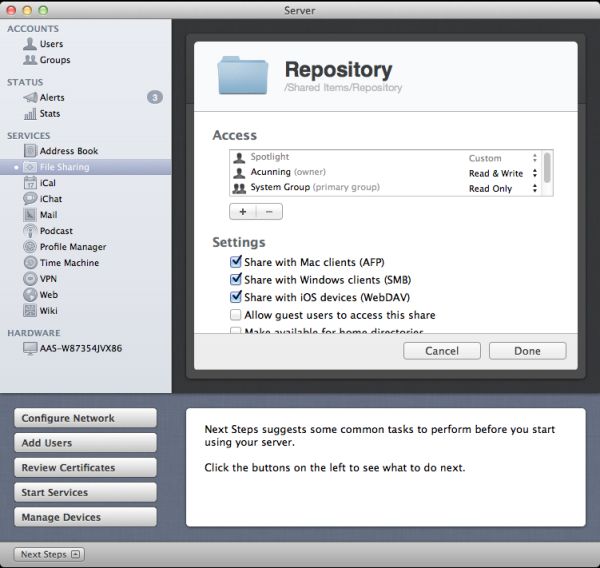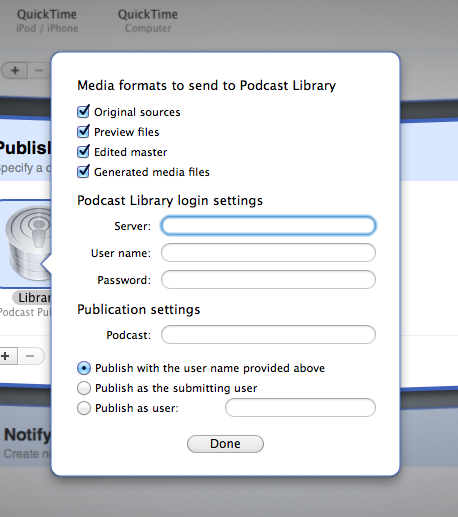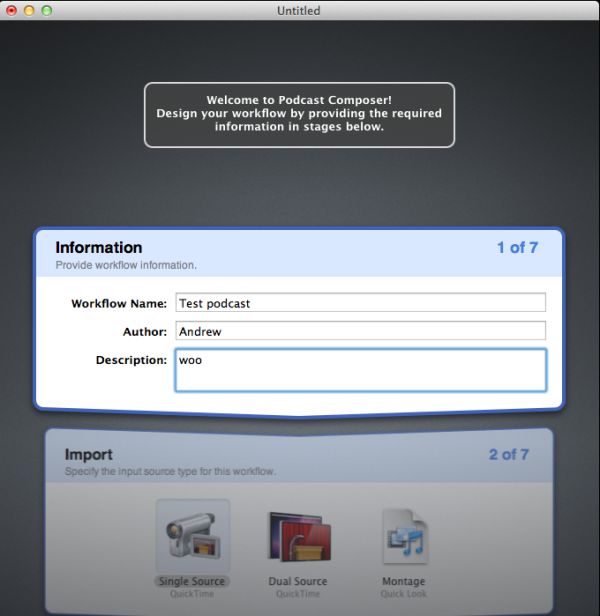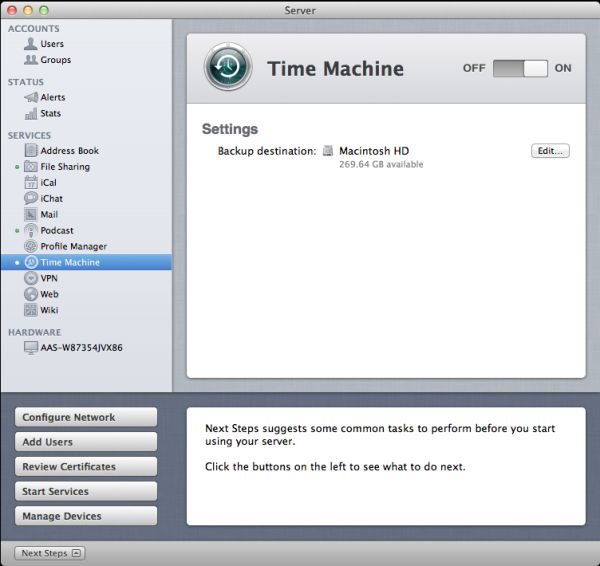In-Depth with Mac OS X Lion Server
by Andrew Cunningham on August 2, 2011 8:00 AM ESTFile Sharing

Click the edit button, and you can control access permissions to each individual folder, as well as what protocols the folders are offered over - AFP for OS X clients, SMB for Windows clients, and WebDAV for iOS clients (many apps, the iOS iWork apps among them, can only connect via WebDAV - this useful new feature is one of the few that could truly justify OS X Server in a home environment).
You may remember from our Lion review that Apple changed up its SMB implementation in Lion. As in the client version, the change shouldn’t affect most server users either: Windows 7, Vista, and XP clients can still connect to SMB shares hosted by OS X Server without issue.
Podcast and Podcast Composer
The Podcast service (which needs the Wiki service to be fully functional, it would seem) works together with the Podcast Composer (another of the Server Admin Tools) to provide end-to-end podcast recording, editing, and hosting. Turn on the Podcast service (and the Wiki service if you haven't already) and then fire up the Podcast Composer.
This program is pretty straightfoward - it builds a podcasting workflow, asking you what you'd like to use to record, what file formats you'd like to export to when done, what fades and wipes you'd like to use - everything a newbie podcaster needs, really (though this does seem to be tailored more to internal-use-only recordings and less to something you'd download from the iTunes store - just an observation). You'll want to specify your server's address under the Publish heading in the default workflow, where you can also specify whether you'd like to save any of the raw files along with the final product.

Once you've successfully published, they're up on your server for everyone with appropriate permissions to see.
Time Machine
Once you do that, your server share becomes selectable from the Time Machine System Preference pane, and it works much the same as Time Machine backups to a local drive.
The thing about the Time Machine service on the Server end has always been one of scale - especially on Apple’s current server hardware, which ship by default with 500GB (Mini) and 1 TB (Mac Pro) hard drives, there’s just not enough storage available to back up dozens of computers unless you spend money on multiple servers or a huge attached storage pool.
In that sense, the Time Machine service actually makes more sense now that Apple server hardware and software are both within reach of the home user. While the Mini’s 500GB of storage (assuming you’re RAIDing your drives, as a good server admin would) might not be enough to backup the two dozen Macs that a small business would have, but it’d be great for the 1-3 Macs that a home user would have. It gives you a good network backup solution if you don’t want to splurge for a Time Capsule or something.
Whatever the case, it’s easy to setup - like most OS X Server services, it’s up to you to decide if it makes sense for you or your organization.













77 Comments
View All Comments
HMTK - Wednesday, August 3, 2011 - link
OK so you can definitely run a Mac OS X vm on vSphere 5 but only on Apple hardware. What a joke! Probably Apple idiocy rather than a technical limitation.Spazweasel - Wednesday, August 3, 2011 - link
Apple is a hardware company. OS/X and iOS exist to make hardware sales possible (thus the cost of development is included in the pricing for Apple hardware, something the Apple haters conveniently overlook) Allowing the running of OS/X on non-Apple hardware reduces Apple hardware sales, so they don't do it."Idiocy"? Yeah, sure, whatever.
HMTK - Wednesday, August 3, 2011 - link
Not allowing Mac OS to run under a hypervisor on non-Apple branded hardware won't help them either. Or do you think a halfway decent IT-department would put a desktop machine or a hard disk posing as a server in a data center? They'd rather pay a few 100 € more for a license if they could run it on ESXi/XenServer/Hyper-V and reliable hardware.Spazweasel - Wednesday, August 3, 2011 - link
Apple makes its money on the desktop, not the server room. I doubt it's worth the effort. OS/X in the server room is a niche product, and Apple know it; it's much more suited as a workgroup/small office server, and those environments do not have ESX or Xen installations.Apple has no incentive to support OS/X in a VM, and plenty of reasons not to. Really, I don't see why this is a surprise.
HMTK - Thursday, August 4, 2011 - link
I'm not saying it's a big surprise, I'm saying it's stupid. why not make good manegement tools for their iOS available in a way that companies can integrate better in their infrastructure?You might be surprised as to how many small shops are going the virtualization route. Even if you have only a single server it makes sense in the long run when the time comes to replace the hardware. Just import the VM on the hypervisor on the new hardware and you're done.
GotThumbs - Tuesday, August 2, 2011 - link
This is an interesting article and I enjoyed the depth of detail. As a builder of my own systems for years, does the use of this software bind you to using only a ready built Apple system? It seems Apple is slowly trying to create a close proprietary system where you have to use apple hardware and apple software. I know their are hackintosh systems but it seems its still going to be quite a bit of effort and so far seems to be a waste of time for me. As the article mentions, there are lots of alternatives available. Apples MO seems to be offering zero options for using outside sources. Apple consumers are being channeled to Itunes and the Mac App Store for all purchases. I'm personally not a fan of that trend and have no intentions of bowing down to that kind of control. I can see where the general consumer who has very little technical knowledge is quite accepting of Apples controls as its a very simple and somewhat brainless system packaged in a slick looking package.GrizzledYoungMan - Tuesday, August 2, 2011 - link
Or is it still something we're all going to pretend works, when it very clearly doesn't out in the real world (If it worked, why would DAVE exist)? I'm referring here to the myriad of permissions issues and oodles of useless garbage sidecar files that pop up after a few days of operation in a mixed environment.Haven't read the article. Probably won't. Sorry. Apple is a joke at anything that designing anything that doesn't fit in your pocket/surrogate vagina of choice.
I get this feeling, deep in my angry muscle, every time some imbecile waves around his iThing, raving about Apple's genius, while I'm thinking about all the time that has been wasted trying to get OS X desktop clients to do things that have worked out in the real world for years now.
blueeyesm - Tuesday, August 2, 2011 - link
Not in Lion, as Samba moved to GPL3 licensing.http://www.appleinsider.com/articles/11/03/23/insi...
GrizzledYoungMan - Tuesday, August 2, 2011 - link
You know what's wild? I should actually be excited they're moving to a new standard - the NAS' I often recommend to clients support SMB2, and see useful performance gains from it.But then I read "Windows networking software developed by Apple" and my heart sinks. Realistically, what are the odds this is going to work?
Honestly, I don't really blame the design teams over there so much as a closed corporate culture that both ignores the feedback of their customers and denies any complaints exist.
They're really missing out on the sorts of improvements that most big software developers make using the information gathered during large, open betas and the like.
repoman27 - Tuesday, August 2, 2011 - link
As the article you linked to points out, since version 10.2 Mac OS X has shipped with Samba, an open-source, reverse engineered version of SMB 1.0. With Lion, Apple dropped Samba and added native support for SMB2 while maintaining the ability to connect with SMB 1.0 machines as long as they use UNICODE and extended security. This means Mac OS X 10.7 can no longer connect out of the box with some SMB 1.0 or Samba machines (which it had done for the last 9 years), but it does have full support for SMB2.As for GrizzledYoungMan's "oodles of useless garbage sidecar files," it's not like Mac users have any use for a thumbs.db file either. Just hide the metadata files, or don't allow write permissions on the folder if you don't want to see that kind of stuff, but these types of files are most likely only going to become more prevalent as time goes by.